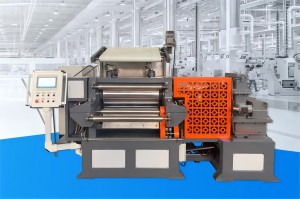
How a Rubber Slicing Machine Enhances Efficiency in Modern Rubber Production
2025-11-11
In our previous discussions, we explored how Calendering and Mixing Mill Machines and Stripping Machines help shape and refine rubber materials. But there’s another unsung hero that plays a crucial role before final product forming — the Rubber Slicing Machine.
This machine might not get as much attention as calenders or mixers, yet it’s vital for precision cutting and preparing rubber sheets or blocks for the next stages of processing. In fact, without accurate slicing, even the best-mixed and calendered rubber could lead to material waste or uneven product performance.
What Is a Rubber Slicing Machine?
A Rubber Slicing Machine is designed to cut thick rubber blocks or sheets into thinner, uniform pieces suitable for subsequent manufacturing steps such as extrusion, molding, or calendaring.
It combines mechanical precision with automated control, ensuring each slice meets exact thickness requirements — down to the millimeter.
Think of it like a chef’s knife in an industrial kitchen — it doesn’t change the recipe, but it makes sure every ingredient is perfectly prepared before cooking.
How It Works: Simple but Precise
The working principle of a Rubber Slicing Machine is quite straightforward yet highly efficient:
-
Feeding System – Rubber sheets or blocks are fed into the machine, either manually or automatically.
-
Positioning – Sensors or guides align the material for consistent slicing.
-
Cutting Mechanism – High-precision blades slice the rubber into pieces of desired thickness.
-
Collection – Finished slices are automatically stacked or conveyed to the next processing line.
When used alongside a Calendering and Mixing Mill Machine, the process becomes seamless: the calendered sheet moves directly into slicing, minimizing handling time and improving accuracy.
Why Slicing Matters: Beyond Cutting
At first glance, slicing may seem like a simple mechanical step. But its impact goes far beyond that. Here’s why it’s essential in a modern rubber production line:
-
Consistency: Evenly sliced rubber ensures uniform performance in final products like seals, gaskets, and tires.
-
Reduced Waste: Accurate slicing maximizes material utilization, saving costs.
-
Efficiency: Automation means faster production with fewer manual adjustments.
-
Compatibility: Works perfectly with upstream machines such as Mixing Mills and Calenders.
It’s one of those steps that customers rarely see — but manufacturers absolutely rely on.
Comparing Rubber Slicing and Stripping Machines
If you’ve been following our earlier blogs, you might wonder: “What’s the difference between a Rubber Slicing Machine and a Stripping Machine?”
Here’s the key distinction:
| Machine Type | Main Function | Typical Output | Ideal For |
|---|---|---|---|
| Stripping Machine | Removes excess layers or prepares surface | Smooth, uniform sheet | Pre-finishing |
| Slicing Machine | Cuts rubber blocks into sheets | Controlled thickness sheets | Material preparation |
In short, stripping focuses on refining surfaces, while slicing focuses on achieving the right thickness. Both are essential and often operate sequentially in the same rubber production line.
Daily Operation Tips for Better Performance
To get the most from your Rubber Slicing Machine, here are a few practical tips — simple but powerful:
-
Always ensure the blade is sharp and properly aligned.
-
Preheat the rubber material slightly for cleaner cuts.
-
Regularly calibrate the thickness setting.
-
Clean the slicing bed after every use to prevent residue buildup.
A little care goes a long way. Consistent maintenance not only improves cutting quality but also extends the lifespan of the machine.
Integrating Slicing into Your Production Line
When connected with Mixing Mills, Calenders, and Stripping Machines, the Rubber Slicing Machine forms part of a complete automated production line.
For instance:
-
Mixing Mill prepares the compound.
-
Calendering Machine presses it into a sheet.
-
Slicing Machine cuts it into precise sizes.
-
Stripping Machine refines the surface before final use.
This integration not only reduces labor costs but also ensures that each step feeds the next perfectly, minimizing errors and boosting overall efficiency.
Conclusion: Precision That Powers Productivity
The Rubber Slicing Machine may seem like a behind-the-scenes tool, but its role in modern manufacturing is essential. By ensuring precise, clean, and consistent cuts, it guarantees smoother downstream processes and higher-quality rubber products.
When paired with Calendering and Mixing Mill Machines and Stripping Machines, it forms a complete, efficient rubber production ecosystem — from raw material to finished product.
So if you’re looking to upgrade your production line, don’t overlook the slicing stage — it might just be the secret to unlocking your factory’s full potential.


